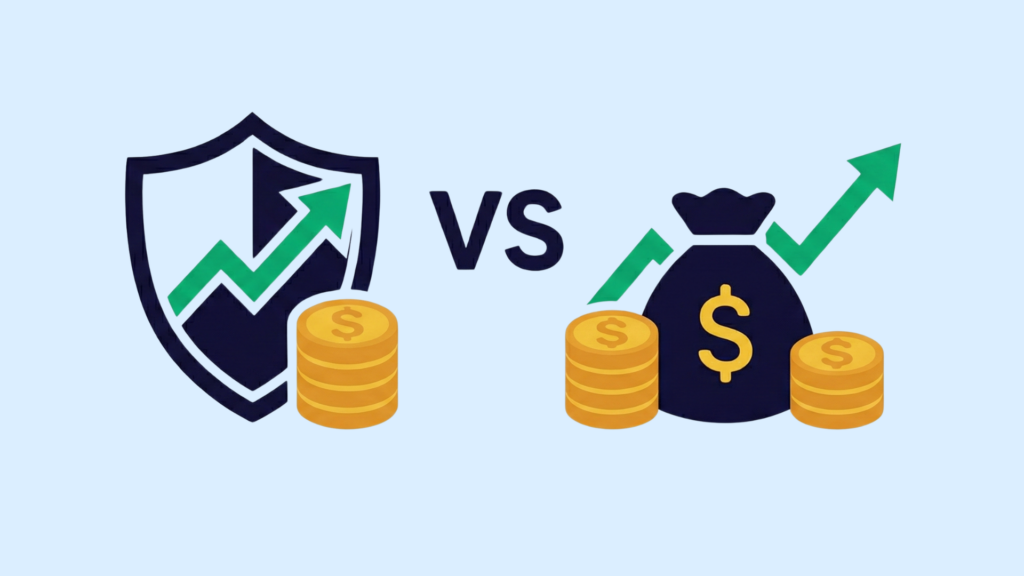A mutual fund’s expense ratio shows the annual cost of managing the fund as a percentage of its total assets. This ratio significantly impacts your returns over time, making it essential to evaluate before investing. This blog will explore how the expense ratio affects your investment’s performance. Read along!
What is a Mutual Fund’s Expense Ratio?
A mutual fund’s expense ratio is an annual fee expressed as a percentage of the fund’s total assets. This ratio reflects the cost of managing the fund, including operational and administrative expenses.
The expense ratio is calculated by dividing the fund’s annual expenses by its average total assets. For example, if a fund has $100 million in assets and $1 million in expenses, its ratio would be 1%.
This ratio clearly shows how much of the fund’s assets are used to cover its costs.
Components of an Expense Ratio
The expense ratio of a mutual fund scheme is computed by dividing the AMC’s total expenses by the value of the assets under managed (AUM). The components of this ratio include:
Management Fees
This charge compensates the people in charge of operating a mutual fund. Portfolio and fund managers spend significant time and effort identifying successful investment opportunities through comprehensive market research and calculated predictions. A mutual fund’s management costs typically range between 0.5 and 1% of its total asset base.
Administrative Costs
This tab includes the cost of ensuring smooth operations and performing other administrative activities. A mutual fund’s maintenance costs include keeping accurate investor records, entry and exit fees for portfolio assets, customer assistance, etc.
12b-1 Fees
This represents the amount spent promoting the relevant mutual fund. Knowledge must be disseminated to the general public to build an appropriate asset base. The charge for a new individual investing in the mutual fund is also computed as part of the 12-b FEE and thus contributes to the fund’s total expense ratio.
Why is the Expense Ratio Important for Investors?
Evaluating the expense ratio is important when selecting a mutual fund because it directly impacts investment returns. A higher expense ratio means more of your investment’s return is used to cover fund costs, potentially reducing overall gains.
Impact on Returns
The expense ratio influences how much of your investment’s return you keep. For example, if you invest $100,000 in a fund with a 12% annual return, a 1% expense ratio would result in a lower net return than a fund with a 0.5% expense ratio.
Over 30 years, this difference becomes significant. With a 1% expense ratio, you might end up with approximately $600,000 less than a fund with a 0.5% expense ratio, assuming similar returns.
This demonstrates how even small variations in expense ratios can lead to considerable differences in your investment growth over the long term.
Comparison Between Active and Passive Funds
Actively managed funds typically have higher expense ratios due to the costs associated with active management, including frequent trading and extensive research. Conversely, passively managed funds, like index funds, have lower expense ratios because they track a market index with minimal adjustments.
Moreover, while active funds may offer the potential for higher returns through expert management, their higher costs need to be justified by superior performance. Passively managed funds provide a cost-effective option with lower fees, making them attractive for long-term investors aiming to reduce costs.
Types of Funds and Their Expense Ratios
Mutual funds come in various types, and their expense ratios can vary significantly based on their investment strategies and management styles. Understanding these differences can help you choose the right fund for your investment goals.
Equity Mutual Funds
Equity mutual funds often have higher expense ratios because they are actively managed. This involves extensive research and frequent trading to select stocks and adjust the portfolio, which increases management and operational costs.
Debt Mutual Funds
Debt mutual funds usually have lower expense ratios compared to equity funds. Managing these funds involves fewer transactions and less intensive research, leading to reduced costs.
Index Funds
Index funds and ETFs (Exchange-Traded Funds) generally have the lowest expense ratios. They are passively managed, meaning they track a market index and do not require active management or frequent trading.
Here’s a table outlining the typical expense ratios for different types of mutual funds:
| Type of Fund | Typical Expense Ratio |
| Equity Mutual Funds | 1.05% to 2.25% (depending on AUM) |
| Debt Mutual Funds | 0.80% to 2.00% (depending on AUM) |
| Index Funds & ETFs | Up to 1.00% |
| Fund of Funds (FOFs) – Equity | Up to 2.25% |
| Fund of Funds (FOFs) – Non-Equity | Up to 2.00% |
| Fund of Funds (FOFs) – Liquid, Index, or ETFs | Up to 1.00% |
How to Evaluate a Mutual Fund’s Expense Ratio?
Evaluating a mutual fund’s expense ratio is important in ensuring your investment is cost-effective. Here’s a step-by-step guide to help you assess the expense ratio of a mutual fund and make informed decisions.
Comparing Similar Funds
Start by comparing the expense ratios of funds within the same category. For example, if you’re looking at large-cap funds, compare their expense ratios with other large-cap funds.
This helps you determine if a fund’s fees are competitive within its category. It’s important because different categories have different cost structures, so a fund’s expense ratio should be evaluated relative to similar options.
Analyzing Long-Term Impact
A small difference in the expense ratio can have a big impact over time. For instance, suppose Fund A has an expense ratio of 0.50% and Fund B has an expense ratio of 0.75%.
If you invest $10,000 in each fund, the difference in annual expenses would be $25. Over 30 years, with an average annual return of 7%, Fund A would grow to about $76,122, while Fund B would grow to about $72,426.
This means Fund B’s higher fees could cost you around $3,696 in potential returns.
When is a Higher Expense Ratio Justified?
A higher expense ratio can concern many investors, but it’s important to recognize scenarios that may be justified. Some of these include:
Performance-Based Justification
A higher expense ratio can be justified if an actively managed fund consistently outperforms its benchmark index. This superior performance often comes from enhanced research, superior risk management, and the expertise of a skilled management team, which can result in higher returns for investors.
Specialized Investment Strategies
Funds that employ specialized investment strategies or focus on niche markets may also have higher expense ratios. These funds require specialized knowledge and more intensive management, which can increase costs but might also offer unique opportunities for higher returns.
The Bottom Line
Evaluating the expense ratio is important when selecting a mutual fund, as it directly impacts your investment returns. Usually, a lower expense ratio means less of your money goes toward fund management, leaving more for your growth.
Additionally, Appreciate trading app simplifies this process by allowing you to easily compare the expense ratios of various mutual funds. This helps you make informed decisions and optimize your investment returns efficiently.
FAQs
What is a mutual fund’s expense ratio?
A mutual fund’s expense ratio represents the annual costs of managing the fund, expressed as a percentage of the fund’s average assets. It includes management fees, administrative expenses, and other costs.
How is the expense ratio calculated?
The expense ratio is calculated by dividing the fund’s total annual expenses by its average net assets. This percentage reflects how much of the fund’s assets are used for operating expenses.
How does the expense ratio affect returns?
The expense ratio impacts returns by reducing the overall gains from the investment, as higher expenses erode the fund’s profits. A lower expense ratio generally means more investment returns stay in your account.
Why do actively managed funds have higher expense ratios?
Actively managed funds usually have higher expense ratios because they involve higher management fees and research costs due to frequent trading and active decision-making. The aim is to outperform the market, which requires more intensive management.
What is a good expense ratio for a mutual fund?
A good expense ratio depends on the fund’s type and strategy; generally, a lower ratio is preferable. An expense ratio under 0.20% is excellent for index funds, while anything under 1% is considered good for actively managed funds.
How does the expense ratio differ between equity and debt funds?
Equity funds often have higher expense ratios due to the higher stock research and trading costs. Debt funds typically have lower expense ratios because they involve less frequent trading and lower research costs.
What is a 12b-1 fee?
A 12b-1 fee is an annual fee charged by mutual funds to cover distribution and marketing expenses, including commissions paid to brokers. It is included in the fund’s expense ratio and typically ranges from 0.25% to 1% of assets.
Are low expense ratios always better?
Low expense ratios are not always better, as they do not account for the fund’s performance or investment strategy. Balancing cost with the fund’s potential returns and management quality is essential.
How do I compare mutual fund expense ratios?
To compare mutual fund expense ratios, look at the ratio percentage for each fund and consider how it aligns with the fund’s performance and investment strategy. Comparing expense ratios among similar funds helps assess the cost-effectiveness of each option.
Can I find expense ratios on mutual fund websites?
Yes, expense ratios are typically listed on mutual fund websites, often in the fund’s fact sheet or prospectus. These documents provide detailed information on the costs associated with the fund.
Disclaimer: Investments in securities markets are subject to market risks. Read all the related documents carefully before investing. The securities quoted are exemplary and are not recommendatory.























